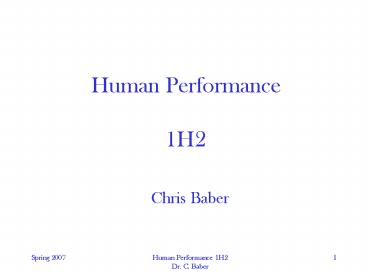Human Performance 1H2
1 / 25
Title: Human Performance 1H2
1
Human Performance 1H2
Chris Baber
2
Assessment
- Course-work (50)
- ONE lab report (45)
- 2500 words
- to be handed in THURSDAY week 11
- to describe data collection and apply principles
from lectures - Attendance of sessions (5)
- Examination (50)
- 2 questions from 3
- 1½ hours
3
Module Objectives
- Relate cognitive psychology to human-centred
system design - Employ basic concepts from cognitive psychology
- Describe the use of products in terms of the
requisite cognitive activities.
4
Reading List
- Norman, D.A.
- The Design of Everyday Things
- New York Basic Books, 1990
- http//www.baddesigns.com/index.shtml
- Noyes, J.M. and Baber, C.
- User-Centred Design of Systems
- Berlin Springer-Verlag, 1999
- Smyth, M.M. et al.
- Cognition in Action
- London LEA, 1987
Matthews, G., Davies, D.R., Westerman, S.J. and
Stammers, R.B., Human Performance London
Psychology Press, 2000 Wickens,
C.D. Engineering Psychology and Human
Performance, New York Harper Collins, 1992
5
Assumptions
- Much of everyday behaviour is automatic
- Requires little conscious control
- Involves learned routines
- Involves expectation (based on previous
experience) - Is error-free (or at least, error-recoverable)
- Is skilled (i.e., well-practised)
6
Seven Stage Action ModelNorman, 1990
GOAL OF PERSON
7
Key point 1
- A User model for designers assumes that people
actively seek information from the environment
and develop expectations of how things work
these expectations influence the ways in which
people seek information.
8
Key Point 2
- Human Behaviour (as far as this lecture course is
concerned) can be defined in terms of - Conscious, rational activity, such as problem
solving - Pre-conscious, automatic activity, such as
schema-driven behaviour
9
Key Point 3
- Problem Solving involves
- Framing
- Through representation
- Through changing states
- Through analogy
- Recognition of affordances in the problem space
10
Problem Solving
- A problem is something that doesnt solve easily
- A problem doesnt solve easily because
- you dont have the necessary knowledge or,
- you have misrepresented part of the problem
- If at first you dont succeed, try something else
- Tackle one part of the problem and other parts
may fall into place
11
Describing Problem Solving
- Move from Initial State to Goal State through
Intervening States (problem space) - More than one solution
- Correct solution limited by boundary conditions
- Active involvement and testing
- Means-Ends Analysis
12
Keypoint 4
- In order to learn the correct representation, it
is necessary to undo the incorrect representation - This means that acquiring new knowledge might
mean effortfully removing erroneous, old
knowledge
13
Key point 5
- PERCEPTION involves a set of active processes
that impose - STRUCTURE,
- STABILITY,
- and MEANING
- on the world
14
Key point 6
- Perception limits are set by sensory / neural
mechanisms but beyond these limits, perception
can be cognitively controlled - Sensory experiences interpreted in a CONTEXT and
derive from a variety of sources
15
Automaticity
- Norman and Shallice (1980)
- Fully automatic processing controlled by SCHEMATA
- Partially automatic processing controlled by
either Contention Scheduling - Supervisory Attentional System (SAS)
16
Supervisory Attentional System Model
Supervisory Attentional System
Control schema
Trigger database
Perceptual System
Effector System
Contention scheduling
17
Contention Scheduling
- Gear changing when driving involves many routine
activities but is performed automatically
without conscious awareness - When routines clash, relative importance is used
to determine which to perform Contention
Scheduling - e.g., right foot on brake or clutch
18
SAS activation
- Driving on roundabouts in France
- Inhibit look right Activate look left
- SAS to over-ride habitual actions
- SAS active when
- Danger, Choice of response, Novelty etc.
19
Attentional Slips and Lapses
- Habitual actions become automatic
- SAS inhibits habit
- Perserveration
- When SAS does not inhibit and habit proceeds
- Distraction
- Irrelevant objects attract attention
- Utilisation behaviour patients with frontal lobe
damage will reach for object close to hand even
when told not to
20
Key point 7
- The design of displayed information INFLUENCES
how the user can use that information - The design of displayed information should
support EXTRACTION of relevant information
21
Density and Clutter
- Density is related to available screen space
- E.g 80 x 24 line display 1920 character spaces
- The proportion of filled spaces Density
- Density averages 25 but rarely exceeds 50
22
Levels of Density
70 density 50 density 30
density
Shneiderman, 1992
23
Reducing Density
Grouping / tabulating Reduce number of words
Reduce number of characters
24
Conclusions
- Understanding basic Gestalt principles helps
manage focus - Some objects on a display are more conspicuous
than others - Use highlighting sparingly
- Some objects form perceptual groups
- Use this to help design screen layout and to
minimise risk of confusion
25
Keypoint 8
- Working memory is a volatile storage medium.
- Do not expect people to remember complex
information, particularly if they are doing
something else at the same time. - Design information to keep within memory limits,
e.g., no more than 9 items to a list































